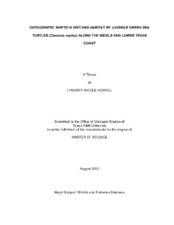| dc.contributor.advisor | Landry, Jr., André M. | |
| dc.creator | Howell, Lyndsey | |
| dc.date.accessioned | 2012-10-19T15:30:57Z | |
| dc.date.accessioned | 2012-10-22T18:05:06Z | |
| dc.date.available | 2014-11-03T19:49:15Z | |
| dc.date.created | 2012-08 | |
| dc.date.issued | 2012-10-19 | |
| dc.date.submitted | August 2012 | |
| dc.identifier.uri | https://hdl.handle.net/1969.1/ETD-TAMU-2012-08-11797 | |
| dc.description.abstract | Effective population management of green sea turtles (Chelonia mydas) necessitates understanding the temporal variation in foraging grounds used in ontogenetic stages, and the effect that the assimilated diet within those habitats has on nutritional gain, growth and eventual reproductive output. Texas coastal waters provide foraging grounds critical to meeting the nutritional needs of green turtles during early life history. To characterize temporal shifts in foraging strategy stomach contents combined with stable carbon (delta13C) and nitrogen (delta15N) isotopes of scute tissue were examined across size classes of stranded juvenile green turtles from the middle and lower Texas coast during 2007-2010. Findings from dietary analysis generally corroborated those from stable isotopes in scute samples. Results indicate green sea turtles exhibit multiple shifts in diet and habitat along the Texas coast. Although isotope values in the tissues of some <25 cm SCL turtles signified recent recruitment to jetty habitat, most in this size class exhibited depleted delta13C and enriched delta15N values indicative of oceanic life. Reinforcing oceanic occupancy from stable isotope results was forage material dominated by oceanic items such as Sargassum spp., Scyphozoa spp., and plastic debris. Diet analysis of 25-34.9 cm SCL turtles implied regional differences existed in macroalgae and seagrass consumption. Enriched delta13C and delta15N values in newest scute suggest most turtles inhabited the jetty environment, where macroalgae is the most available forage. A definitive shift by >35 cm SCL turtles to inshore seagrass habitat was revealed by a diet of seagrasses and tissue enriched in delta13C and depleted in delta15N. This is the first study to integrate stomach contents of several green turtle size classes with tissue analysis of stable isotopes. The combination of these techniques provided an assessment of the effectiveness of stable isotope analyses in documenting diet and habitat shifts. Stomach content examination determined the most recent diet consumed within the habitat occupied, whereas stable isotope analysis provided a time-integrated synopsis of diet and habitat shifts. Findings indicate integration of stomach content and stable isotope analysis is highly effective for characterizing habitat use and foraging strategy of ontogenetic-stage green sea turtles. | en |
| dc.format.mimetype | application/pdf | |
| dc.language.iso | en_US | |
| dc.subject | Sea Turtles | en |
| dc.subject | Ontogenetic Shifts | en |
| dc.subject | Foraging Ecology | en |
| dc.subject | Stomach Content Analysis | en |
| dc.subject | Stable Isotope Analysis | en |
| dc.title | Ontogenetic Shifts in Diet and Habitat by Juvenile Green Sea Turtles (Chelonia mydas) along the Middle and Lower Texas Coast | en |
| dc.type | Thesis | en |
| thesis.degree.department | Wildlife and Fisheries Sciences | en |
| thesis.degree.discipline | Wildlife and Fisheries Sciences | en |
| thesis.degree.grantor | Texas A&M University | en |
| thesis.degree.name | Master of Science | en |
| thesis.degree.level | Masters | en |
| dc.contributor.committeeMember | Feagin, Rusty E. | |
| dc.contributor.committeeMember | Neill, William H. | |
| dc.contributor.committeeMember | Reich, Kimberly J. | |
| dc.contributor.committeeMember | Shaver, Donna J. | |
| dc.type.genre | thesis | en |
| dc.type.material | text | en |
| local.embargo.terms | 2014-10-22 | |


